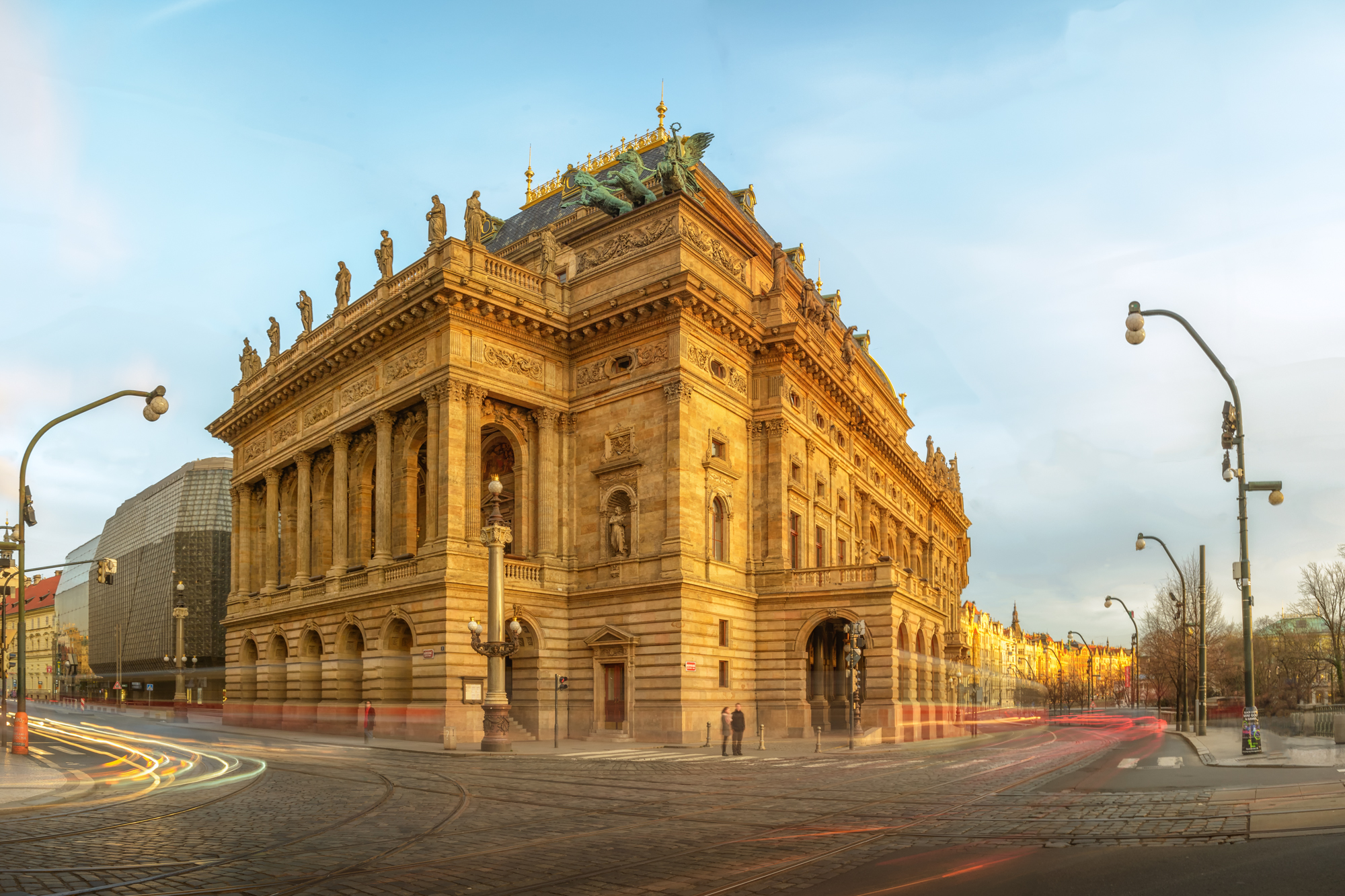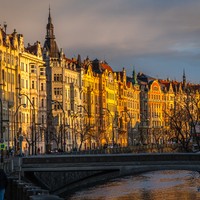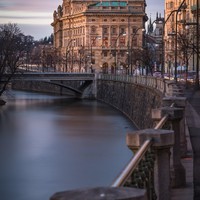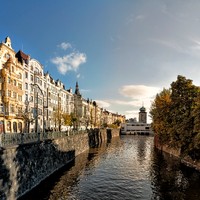Breadcrumbs navigation
The Masaryk Embankment

If we had to choose the most beautiful of all Prague waterfronts, the Masaryk Embankment would surely win the prize. This row of extraordinary buildings lining the right bank of the Vltava River from the Legionnaires’ Bridge to the Jirásek Bridge is one of the most photogenic sights in Prague.
Published on March 12, 2021
With the exception of the short section between the National Theater and Na Struze Street, which is older and was created in connection with the construction of the original chain bridge, the waterfront was built after 1903. It is interesting to note that this is probably the most frequently renamed embankment in Prague. Over the course of the last century, the name of this riverside boulevard changed numerous times. It was originally named after Emperor František (Francis) I. In 1912, it was renamed the Rieger Embankment after the prominent Czech politician of the late 19th century. During World War I, it was called the Vltava Embankment, and in 1942 it was renamed after Heydrich. After World War II ended, the name Rieger was briefly reinstated, and President Clement Gottwald was the inspiration for its final pre-revolution moniker. It has borne the name of the first Czechoslovak President T. G. Masaryk since 1990.
It is interesting to imagine how this part of the Vltava River looked in the late 19th century before city planning regulations came into effect. Between the Jirásek Bridge and the gleaming white Mánes Palace, where you can stroll along the upper embankment as well as by the water, there was a rafting yard. It became one of the places where the sandmen gathered in the summer and the icemen gathered in winter to carry out their trades. This was also the case on the shore across from Slavonic Island, known as Žofín. A plethora of mills crowded the Vltava River channel, alongside the public baths, laundries, and buildings on the bank of the Vojtěch district (Vojtěšska čtvrť). These were often workshops, manufacturers, and small factories that were water-dependent.
After the Vojtěch district was redeveloped, the situation changed significantly. The waterfront was lowered to water level – in some places up to 50 m. This created a street lined with luxury houses, which are a true showcase of early 20th century architecture in Prague. Let’s take a closer look at some of them.
Begin your walk along the Masaryk Embankment by exploring one of its most important buildings - the National Theater. This structure has dominated the waterfront since it first opened in 1881. After a devastating fire while finishing work was being completed on the building, it was restored within two years. The monumental neo-Renaissance building is the work of the architects Josef Zítek and Josef Schulz. Many artists contributed to its rich exterior and interior decoration, a group now called the “National Theater Generation”, despite the fact that they spanned three generations in age. Leading works by Mikoláš Aleš, František Ženíšek, Vojtěch Hynais, Josef Václav Myslbek and others can be found here.

A short distance along the waterfront is a series of beautifully decorated Art Nouveau houses, dominated by the grandiose corner palace of the First Czech Security Bank, now home to the Goethe–Institut (building no. 224/32) The architect Jiří Stibral designed this striking building and Ladislav Šaloun was responsible for the building’s sculptural decoration.

Building no. 236/30 is also worth a closer look. The complex façade with very prominent decoration by the painter Ladislav Novák makes a deep first impression. He painted scenes depicting water-based fairytale creatures, as well as the actual appearance of the waterfront. During the interwar period, the Riviera Café on the first floor was a popular destination, as demonstrated by the inscription in the forged railing of the balcony and the current café bar of the same name on the ground floor.
Two other neighboring buildings, no. 234/26 and no. 235/28, are also excellent examples of early 20th century architecture. The project and co-owner of the first was Kamil Hilbert, an architect who devoted nearly his entire professional life to the construction of St Vitus’ Cathedral at Prague Castle. The slightly more modest second building was designed by the owner of one of the most important construction companies in Prague, Matěj Blecha, as illustrated by the monogram in the gable.
A true gem in this block of houses is the Art Nouveau Hlahol House (no. 248/16) built from 1904-1905 based on designs by Josef Fanta and František Schlaffer. The building was home to the Hlalol Choral Society. Inside there is a concert hall with a glass ceiling and busts of choirmasters, a small organ, and a large lunette with a painting by Alfonso Mucha called the Czech Song. The building occupies the whole block through to Vojtěšská Street. The mission of the choral society is referenced with the slogan “Music of our soul, soul of our homeland” inscribed on both richly decorated facades.
Further up the Vltava River is the prominent Renaissance Šítkov Water Tower, which served as an observation tower for the Communist state security service, from which they monitored the nearby apartment of former dissident and later first post-revolutionary President Václav Havel. Built in the second half of the 16th century, the tower’s current appearance dates from 1651 and it was functional until 1881. It was surrounded by mills and the waterworks. Between 1928 and 1930, the unique functionalist building of the Mánes Association of Fine Arts (no. 250/1) was built in their place. The Association was founded jointly in 1887 by students of the School of Applied Arts and the Fine Arts Academy and was the real center of the artistic life for several generations. The Association’s permanent home, which included exhibition areas and a restaurant with a café, was designed and built by leading architect Otakar Novotný.

The walk along the Masaryk Embankment would not be complete without a visit to Slavonic Island, also known as Žofín, where the 1880s Classicist palace of the same name designed by Jindřich Fialka presides. Since its construction, the building has been one of the most important centers of Prague’s social and cultural life. The island was formed by successive deposits of land behind the Šítkov Mills and used to be much smaller. It reached its current dimensions in 1784 after a major flood, after which protective walls were built. The tranquil atmosphere of the park is a great place to relax. There is also a great garden restaurant, a popular children’s playground, and several rowboat and pedal boat rentals.
Our tour finishes in the small back streets of the Vojtěch district, which starts literally around the corner. The neighborhood is named after the Church of St Vojtěch (Adalbert), with its standalone bell tower. The prominent Czech composer Antonín Dvořák worked as the organist here between 1874 and 1877. A commemorative plaque documents this fact. Near the church, on the corner of the Pštrossova Street, a plaque commemorates the foundation of the first Czech girl’s gymnasium Minerva, which was based here, and the Czech writer Eliška Krásnohorská, who was behind its foundation.
 Prague City Tourism
Prague City Tourism
Prague City Tourism (PCT) is a joint stock company 100% owned by the Capital City of Prague and is the certified official organization for Prague City Hall destination management. Its main mission is to promote sustainable domestic and inbound international tourism in the capital.




